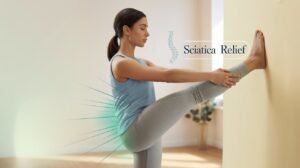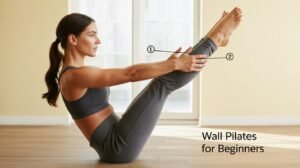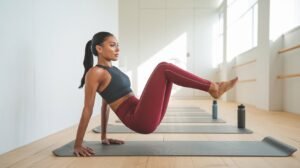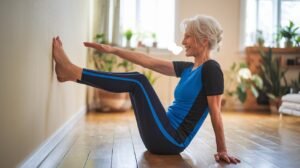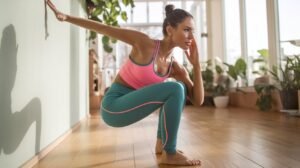At the heart of every Pilates practice lies the concept of the “Powerhouse”—a term that refers to the core muscles that form the foundation of all movement. Wall Pilates, a modern twist on traditional Pilates, leverages the support and resistance of a wall to enhance core engagement and stability. At Wall Pilates Workouts, we are passionate about helping you understand and activate your Powerhouse effectively through Wall Pilates exercises, ensuring a stronger, more balanced body.
Understanding the Powerhouse
The Powerhouse, also known as the core, encompasses the muscles of the abdomen, lower back, hips, and pelvic floor. Joseph Pilates, the founder of Pilates, believed that a strong Powerhouse is essential for overall health and movement efficiency. The primary muscles involved include:
- Rectus Abdominis: The “six-pack” muscles that run vertically along the front of the abdomen.
- Transversus Abdominis: The deep abdominal muscles that wrap around the torso, providing core stability.
- Obliques: The muscles on the sides of the abdomen that aid in rotation and lateral movement.
- Erector Spinae: The muscles along the spine that help maintain posture and support back movement.
- Pelvic Floor Muscles: The muscles that support the pelvic organs and assist in controlling movements.
How Wall Pilates Enhances Core Engagement
Wall Pilates is particularly effective in engaging the Powerhouse due to the added stability and resistance provided by the wall. Here’s how Wall Pilates targets the core muscles effectively:

1. Increased Stability
Using the wall as a support enhances stability, allowing you to focus more on activating your core muscles without compromising balance. This stability is crucial for performing exercises with proper form and maximizing core engagement.
Example Exercise: Wall Plank with Knee Tuck
- Place your hands on the wall at shoulder height and step back into a plank position.
- Bring one knee towards your chest, engaging your core to maintain balance.
- Return to the starting position and repeat with the other leg.
Benefits:
- Strengthens the rectus abdominis and obliques.
- Enhances balance and core stability.
2. Resistance to Deep Muscle Activation
The wall provides resistance that challenges the deeper layers of the core muscles, particularly the transversus abdominis. This resistance helps to build a strong, stable core that supports all movements.
Example Exercise: Wall Roll-Down with Resistance
- Stand with your back against the wall, feet slightly away from it.
- Hold a resistance band in your hands and slowly roll down through your spine, reaching towards your toes.
- Roll back up with control, engaging your core and using the resistance band for added challenge.
Benefits:
- Activates the transversus abdominis and rectus abdominis.
- Improves spinal flexibility and core strength.
3. Focus on Alignment and Form
The wall serves as a guide for maintaining proper alignment and form during exercises. This focus on alignment ensures that the core muscles are engaged correctly and efficiently, reducing the risk of injury.
Example Exercise: Wall Squat with Pelvic Tilt
- Stand with your back against the wall and feet hip-width apart.
- Slide down into a squat position, keeping your knees aligned with your toes.
- Tilt your pelvis slightly to engage the lower abdominal muscles and maintain a neutral spine.
Benefits:
- Strengthens the lower abdominal muscles and improves posture.
- Enhances awareness of pelvic alignment and core engagement.
4. Controlled Movement and Flow
Wall Pilates emphasizes slow, controlled movements that require sustained core engagement. This controlled approach not only strengthens the core muscles but also improves their endurance and ability to support the body during dynamic activities.
Example Exercise: Wall Leg Lift Series
- Lie on your back with your legs extended up the wall and your hands by your sides.
- Slowly lift one leg off the wall, maintaining control and engaging your core.
- Lower the leg back down and repeat with the other leg.
Benefits:
- Targets the lower abdominal muscles and hip flexors.
- Promotes control and precision in core movements.
Key Wall Pilates Exercises for Core Engagement
To help you harness the power of your core through Wall Pilates, here are some essential exercises that focus on engaging the Powerhouse:

1. Wall Hundred
How to Perform:
- Lie on your back with your legs raised and pressed against the wall, forming a right angle at the hips.
- Lift your head and shoulders off the floor, reaching your arms forward.
- Pump your arms up and down while breathing in for five counts and out for five counts, completing 10 cycles.
Benefits:
- Engages the entire core, including the rectus abdominis and transversus abdominis.
- Improves coordination and endurance.
2. Wall Roll-Up
How to Perform:
- Sit with your back against the wall, legs extended, and feet flexed.
- Slowly roll up through your spine, reaching towards your toes while maintaining contact with the wall.
- Roll back down with control, focusing on engaging your core throughout the movement.
Benefits:
- Strengthens the abdominal muscles and enhances spinal flexibility.
- Promotes deep core activation and control.
3. Wall Side Bend
How to Perform:
- Stand with your side against the wall, feet together.
- Slide your hand down the side of your leg as you lean towards the wall, engaging your obliques.
- Return to the starting position and repeat on the other side.
Benefits:
- Targets the obliques and improves lateral flexibility.
- Enhances balance and core stability.
4. Wall Bridge with Leg Lift
How to Perform:
- Lie on your back with your feet flat against the wall, knees bent.
- Lift your hips into a bridge position, squeezing your glutes and engaging your core.
- Lift one leg off the wall, maintaining stability, and hold for a few seconds.
- Lower the leg and repeat with the other side.
Benefits:
- Strengthens the lower back, glutes, and core.
- Improves pelvic stability and balance.
Incorporating Wall Pilates into Your Routine
To effectively engage your Powerhouse and build a strong core, integrate Wall Pilates exercises into your regular fitness routine. Start with a few foundational exercises and gradually increase the intensity and complexity as you build strength and confidence. Aim to practice Wall Pilates 2-3 times per week, focusing on precise and controlled movements.
For guided sessions and more information on Wall Pilates, visit Wall Pilates Workouts. Our resources and classes are designed to help you master the art of Wall Pilates and fully engage your Powerhouse.
Conclusion
Engaging your core effectively is essential for overall strength, stability, and movement efficiency. Wall Pilates offers a unique and powerful way to activate the Powerhouse, combining the support and resistance of a wall with the principles of controlled movement. By incorporating Wall Pilates into your fitness routine, you can achieve a stronger, more balanced body and enhance your overall well-being. Join us at Wall Pilates Workouts and discover the transformative power of Wall Pilates for your core.


